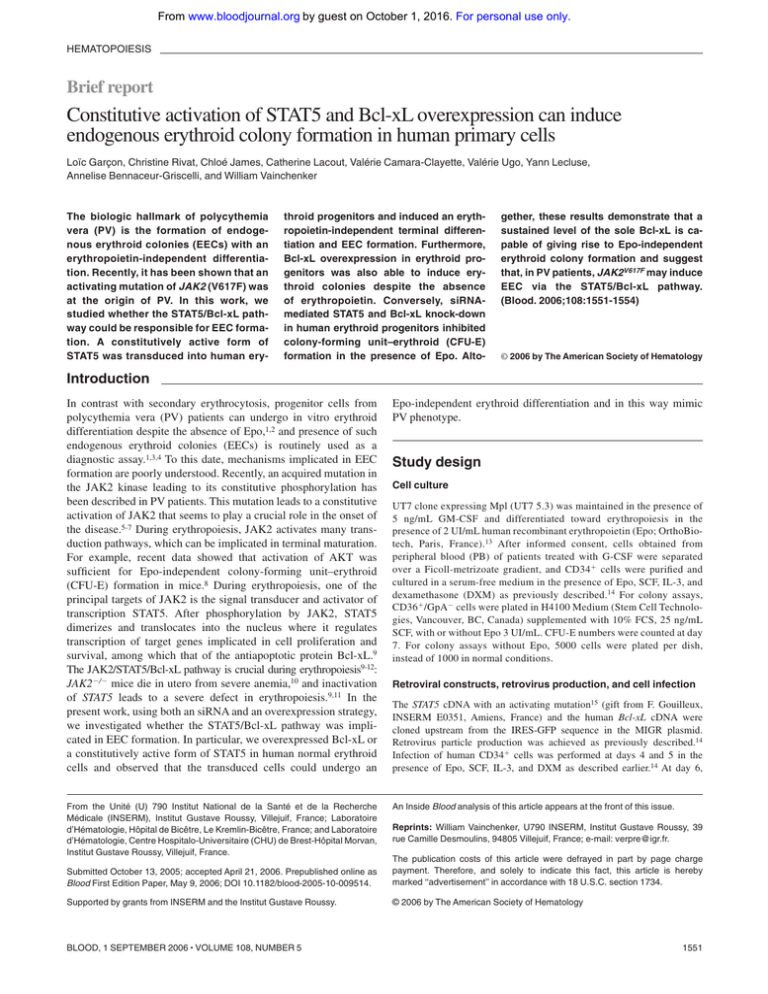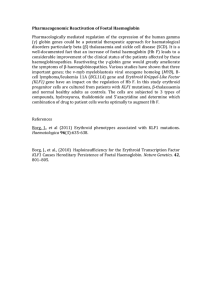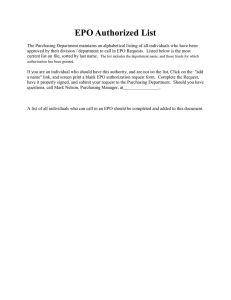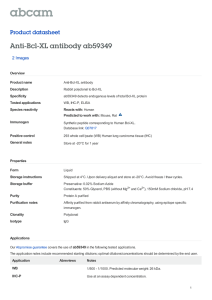
From www.bloodjournal.org by guest on October 1, 2016. For personal use only.
HEMATOPOIESIS
Brief report
Constitutive activation of STAT5 and Bcl-xL overexpression can induce
endogenous erythroid colony formation in human primary cells
Loı̈c Garçon, Christine Rivat, Chloé James, Catherine Lacout, Valérie Camara-Clayette, Valérie Ugo, Yann Lecluse,
Annelise Bennaceur-Griscelli, and William Vainchenker
The biologic hallmark of polycythemia
vera (PV) is the formation of endogenous erythroid colonies (EECs) with an
erythropoietin-independent differentiation. Recently, it has been shown that an
activating mutation of JAK2 (V617F) was
at the origin of PV. In this work, we
studied whether the STAT5/Bcl-xL pathway could be responsible for EEC formation. A constitutively active form of
STAT5 was transduced into human ery-
throid progenitors and induced an erythropoietin-independent terminal differentiation and EEC formation. Furthermore,
Bcl-xL overexpression in erythroid progenitors was also able to induce erythroid colonies despite the absence
of erythropoietin. Conversely, siRNAmediated STAT5 and Bcl-xL knock-down
in human erythroid progenitors inhibited
colony-forming unit–erythroid (CFU-E)
formation in the presence of Epo. Alto-
gether, these results demonstrate that a
sustained level of the sole Bcl-xL is capable of giving rise to Epo-independent
erythroid colony formation and suggest
that, in PV patients, JAK2V617F may induce
EEC via the STAT5/Bcl-xL pathway.
(Blood. 2006;108:1551-1554)
© 2006 by The American Society of Hematology
Introduction
In contrast with secondary erythrocytosis, progenitor cells from
polycythemia vera (PV) patients can undergo in vitro erythroid
differentiation despite the absence of Epo,1,2 and presence of such
endogenous erythroid colonies (EECs) is routinely used as a
diagnostic assay.1,3,4 To this date, mechanisms implicated in EEC
formation are poorly understood. Recently, an acquired mutation in
the JAK2 kinase leading to its constitutive phosphorylation has
been described in PV patients. This mutation leads to a constitutive
activation of JAK2 that seems to play a crucial role in the onset of
the disease.5-7 During erythropoiesis, JAK2 activates many transduction pathways, which can be implicated in terminal maturation.
For example, recent data showed that activation of AKT was
sufficient for Epo-independent colony-forming unit–erythroid
(CFU-E) formation in mice.8 During erythropoiesis, one of the
principal targets of JAK2 is the signal transducer and activator of
transcription STAT5. After phosphorylation by JAK2, STAT5
dimerizes and translocates into the nucleus where it regulates
transcription of target genes implicated in cell proliferation and
survival, among which that of the antiapoptotic protein Bcl-xL.9
The JAK2/STAT5/Bcl-xL pathway is crucial during erythropoiesis9-12:
JAK2⫺/⫺ mice die in utero from severe anemia,10 and inactivation
of STAT5 leads to a severe defect in erythropoiesis.9,11 In the
present work, using both an siRNA and an overexpression strategy,
we investigated whether the STAT5/Bcl-xL pathway was implicated in EEC formation. In particular, we overexpressed Bcl-xL or
a constitutively active form of STAT5 in human normal erythroid
cells and observed that the transduced cells could undergo an
From the Unité (U) 790 Institut National de la Santé et de la Recherche
Médicale (INSERM), Institut Gustave Roussy, Villejuif, France; Laboratoire
d’Hématologie, Hôpital de Bicêtre, Le Kremlin-Bicêtre, France; and Laboratoire
d’Hématologie, Centre Hospitalo-Universitaire (CHU) de Brest-Hôpital Morvan,
Institut Gustave Roussy, Villejuif, France.
Epo-independent erythroid differentiation and in this way mimic
PV phenotype.
Study design
Cell culture
UT7 clone expressing Mpl (UT7 5.3) was maintained in the presence of
5 ng/mL GM-CSF and differentiated toward erythropoiesis in the
presence of 2 UI/mL human recombinant erythropoietin (Epo; OrthoBiotech, Paris, France).13 After informed consent, cells obtained from
peripheral blood (PB) of patients treated with G-CSF were separated
over a Ficoll-metrizoate gradient, and CD34⫹ cells were purified and
cultured in a serum-free medium in the presence of Epo, SCF, IL-3, and
dexamethasone (DXM) as previously described.14 For colony assays,
CD36⫹/GpA⫺ cells were plated in H4100 Medium (Stem Cell Technologies, Vancouver, BC, Canada) supplemented with 10% FCS, 25 ng/mL
SCF, with or without Epo 3 UI/mL. CFU-E numbers were counted at day
7. For colony assays without Epo, 5000 cells were plated per dish,
instead of 1000 in normal conditions.
Retroviral constructs, retrovirus production, and cell infection
The STAT5 cDNA with an activating mutation15 (gift from F. Gouilleux,
INSERM E0351, Amiens, France) and the human Bcl-xL cDNA were
cloned upstream from the IRES-GFP sequence in the MIGR plasmid.
Retrovirus particle production was achieved as previously described.14
Infection of human CD34⫹ cells was performed at days 4 and 5 in the
presence of Epo, SCF, IL-3, and DXM as described earlier.14 At day 6,
An Inside Blood analysis of this article appears at the front of this issue.
Reprints: William Vainchenker, U790 INSERM, Institut Gustave Roussy, 39
rue Camille Desmoulins, 94805 Villejuif, France; e-mail: verpre@igr.fr.
Submitted October 13, 2005; accepted April 21, 2006. Prepublished online as
Blood First Edition Paper, May 9, 2006; DOI 10.1182/blood-2005-10-009514.
The publication costs of this article were defrayed in part by page charge
payment. Therefore, and solely to indicate this fact, this article is hereby
marked ‘‘advertisement’’ in accordance with 18 U.S.C. section 1734.
Supported by grants from INSERM and the Institut Gustave Roussy.
© 2006 by The American Society of Hematology
BLOOD, 1 SEPTEMBER 2006 䡠 VOLUME 108, NUMBER 5
1551
From www.bloodjournal.org by guest on October 1, 2016. For personal use only.
1552
GARÇON et al
CD36⫹/GpA⫺/GFP⫹ cells were sorted and cultured in a serum-free medium
supplemented with 25 ng/mL SCF with or without Epo or plated in
methylcellulose as described in “cell culture”.
SiRNA experiments
Day-5 CD36⫹ erythroid progenitors were electroporated with siRNA
targeted on STAT516 or Bcl-xL,17 or with a nonspecific control by means
of the nucleofactor technique (Amaxa Biosystems, Gaithersburg,
MD). After 24 hours, GpA⫺ cells were plated in methylcellulose for
CFU-E assays.
Results and discussion
Recent focus on the JAK2V617F mutation in PV patients argues
for a direct implication of JAK2-dependent signaling pathways
in EEC formation.5,6 Because STAT5 is the principal JAK2
Figure 1. STAT5 and Bcl-xL can induce erythroid differentiation. (A) A constitutively
active form of STAT5 induced erythroid differentiation in UT7 cells. UT7 cells were
transduced either with the empty retrovirus MIGR or with the retrovirus coding for a
constitutively phosphorylated STAT5 (STAT5CA). After cell sorting according to GFP
expression, cells were cultured in the presence of GM-CSF, without Epo. GpA
expression was monitored by flow cytometry at day 4 after retrovirus infection. In the
cells expressing STAT5CA, the percentage of GpA⫹ cells was much greater than in
UT7 transduced with the empty vector (MIGR: 9% ⫾ 1%; STAT5CA: 30% ⫾ 3%;
n ⫽ 3; Student t test: P ⫽ .004). (B) STAT5CA expression in human primary
progenitors induced Epo-independent terminal erythroid differentiation. CD34⫹ cells
from PB were cultured in the presence of Epo, SCF, IL-3, and DXM and then
transduced twice with the different retroviral vectors (MIGR or STAT5CA). Transduced CD36⫹/GpA⫺ cells were sorted at day 6 and cultured in the presence of SCF
without Epo. Flow cytometry analysis showed 48 hours later that the percentage of
GpA⫹ cells was higher with STAT5CA (48% ⫾ 6%) than with the empty vector MIGR
(19% ⫾ 2%; n ⫽ 3; Student t test: P ⫽ .04). Determination of GpA expression was
done using a more sensitive cell analyzer than the one used for cell sorting, and this
explains why around 20% of the MIGR-transduced cells were found GpA positive.
Moreover, cells transduced with the empty vector died after 48 hours of Epo removal,
whereas STAT5CA-expressing cells further survived and proliferated (data not
shown). (C) Bcl-xL overexpression in human primary progenitors induced GpA
expression despite the absence of Epo. Primary cells were transduced either with the
empty vector MIGR or with a vector coding for the Bcl-xL cDNA. Two days after cell
sorting and Epo removal, 38% ⫾ 4% of Bcl-xL–overexpressing cells were GpA
positive, whereas only 18% ⫾ 4% of cells infected with the empty vector MIGR were
GpA positive (n ⫽ 3; Student t test: P ⫽ .04). Data are represented as mean ⫾ SEM.
As observed in STAT5CA-expressing cells, Bcl-xL–overexpressing cells could further
proliferate and differentiate. When transduced with the empty vector, all cells died 48
hours after EPO removal.
BLOOD, 1 SEPTEMBER 2006 䡠 VOLUME 108, NUMBER 5
target in erythroid cells, we investigated whether EEC formation
was dependent only on STAT5 activation or required other
signaling pathways that would be activated by JAK2. For this
purpose, we used a retroviral vector coding for a constitutively active form of STAT5 (STAT5CA), which is spontaneously translocated into the nucleus.15 After transduction in UT7
cells, a leukemic cell line with erythroid properties, this vector
led to a spontaneous induction of GpA expression despite the
absence of Epo (Figure 1A). We next investigated effects of
STAT5CA on erythroid differentiation of human primary progenitors. Purified PB CD34⫹ cells were cultured in a serum-free
medium as described in “Materials and methods.” After transduction with the STAT5CA vector, CD36⫹/GpA⫺/GFP⫹ cells were
sorted and cultured in the presence of SCF alone. As shown
previously, these cells correspond to erythroid progenitors at a
CFU-E stage and are dependent on Epo for their survival and
terminal differentiation.14 After STAT5CA expression, they
could undergo erythroid terminal differentiation despite the
absence of Epo (Figure 1B).
Because STAT5 has been shown to play a crucial role in
erythropoiesis through induction of the antiapoptotic protein
Bcl-xL,9,11 we next investigated whether effects of STAT5CA
were dependent on Bcl-xL induction. We cloned the coding
sequence of human Bcl-xL in the retroviral vector MIGR. As
shown in Figure 1C, overexpression of Bcl-xL in CD36⫹/GpA⫺
cells induced GpA expression despite the absence of Epo. Thus,
both constitutive activation of STAT5 and Bcl-xL overexpression could substitute for Epo to induce terminal differentiation
of primary erythroid progenitor cells. Of interest, an immunostaining experiment showed that these 2 vectors increased levels
of Bcl-xL protein in erythroid progenitors (data not shown).
These levels, however, did not exceed those observed in
physiological conditions after Epo exposure. This is in agreement with recent data showing an effect of Bcl-xL on erythroid
differentiation, either in the FDCP cell line18 or in primary
mouse erythroblasts.19 This effect may be partly independent of
Bcl-xL antiapoptotic properties because Bcl2, another antiapoptotic factor, is not able to induce EEC in transgenic mice,20 and
its overexpression induces granulocytic but not erythroid differentiation in FDCP cells.18
In order to investigate the importance of the STAT5/Bcl-xL
pathway in CFU-E formation, we transduced CD36⫹ progenitor
cells with an siRNA targeted on STAT5 or Bcl-xL, and plated
them in methylcellulose for CFU-E assays. We observed with
either STAT5 or Bcl-xL siRNA a drastic reduction of cloning
efficiency (Figure 2A). Deregulation of these proteins could
therefore be implicated in EEC formation observed in PV cells.
Since a high Bcl-xL expression has been described in PV
erythroid progenitors,21 we investigated whether STAT5CA or
Bcl-xL overexpression could reproduce the malignant phenotype (ie, formation of EEC) as do PV cells. PB CD34⫹ cells were
cultured in a serum-free medium and transduced with the
different retroviruses at days 4 and 5. CD36⫹/GpA⫺/GFP⫹ cells
were sorted at day 7 and plated in methylcellulose with or
without Epo. In the presence of Epo, total CFU-E number was
higher with the STAT5CA or the Bcl-xL vector than with the
control (Figure 2B). Without Epo, Bcl-xL as well as STA5CA
vectors could induce EEC (Figure 2C). However, STAT5CA
expression led to a greater number of colonies, whereas Bcl-xL
overexpression induced smaller ones similar to those observed
in PV patients (Figure 2D). These differences could be due to
From www.bloodjournal.org by guest on October 1, 2016. For personal use only.
BLOOD, 1 SEPTEMBER 2006 䡠 VOLUME 108, NUMBER 5
ROLE OF THE STAT5/Bcl-xL PATHWAY IN EEC FORMATION
1553
Figure 2. STAT5 and Bcl-xL are implicated in EEC formation. (A) Inhibition of Bcl-xL and STAT5 in primary cells using an siRNA strategy decreased CFU-E formation. Day-5
CD36⫹ cells cultured in the presence of Epo, DXM, IL-3, and SCF were electroporated with siRNA targeted on either STAT5 or Bcl-xL, or with a nonspecific control sequence.
GpA⫺ cells were plated at day 6 in methylcellulose in the presence of Epo and SCF. CFU-Es were counted 7 days later. Number of CFU-Es was significantly reduced after
knock-down of either STAT5 or Bcl-XL compared with the control (n ⫽ 3; Student t test: P ⬍ .05). (B-C) A constitutively active form of STAT5 as well as Bcl-xL overexpression
induced EEC formation in methylcellulose assays. PB CD34⫹ cells were cultured in the presence of Epo, SCF, IL-3, and DXM, transduced at days 4 and 5 either with the MIGR,
STAT5CA, or Bcl-xL vectors. At day 7, CD36⫹/GpA⫺/GFP⫹ cells were sorted, and 5000 cells were plated in methylcellulose in the presence of SCF alone. As a positive control,
1000 cells were plated in parallel in the presence of SCF and Epo. Histograms represent the total number of CFU-Es at day 7. In the presence of Epo, the CFU-E number was
higher with the STAT5CA and the Bcl-xL vectors than with the control (B). In the absence of Epo (C), whereas MIGR-transduced cells did not give rise to a significant number of
CFU-Es, either STAT5CA or Bcl-xL vectors could induce EEC formation (n ⫽ 3, each in triplicate; Student t test: STAT5CA vs MIGR, P ⬍ .05; Bcl-xL vs MIGR, P ⬍ .05). Data
are represented as mean ⫾ SEM. (D) Qualitative differences between STAT5CA-induced (left) and Bcl-xL–induced (right) EECs. Bcl-xL–induced EECs were not only less
numerous (Student t test: P ⫽ .001), but also contained a lower number of cells than the STAT5CA-induced CFU-Es. These Bcl-xL–induced EECs were very similar to those
routinely observed in PV patients. CFUs were counted using a Zeiss Telaval 31 microscope (Zeiss, Oberkochen, Germany) and a 20⫻/0.35 numeric aperture objective
(Micromecanique, Evry, France). Images were captured using a Nikon Eclipse TE300 microscope (Nikon, Tokyo, Japan) connected to a Zeiss Axiocam digital camera. Images
were acquired using Zeiss Axiovision 4 software.
recruitment of other targets activated by STAT5, especially
genes implicated in the cell cycle.
Considering these results, we hypothesized that the EEC
formation observed in myeloproliferative disorders could be
partially due to the JAK2-dependent activation of the STAT5/
Bcl-xL pathway. In agreement with this, JAK2 inhibitors have
been shown to inhibit Epo-independent terminal differentiation
of PV cells.22 Moreover, when JAK2V617F was expressed in the
IL-3–dependent cell line BaF3, a spontaneous STAT5 phosphorylation could be detected in the absence of cytokine.6,7 Whether
this mutation requires a functional Epo-R and STAT5 to induce
EEC formation via an Epo-independent Bcl-xL induction in PV
erythroid cells is still under investigation.
Acknowledgments
We are grateful to Frederic Larbret for cell sorting experiments, and
to Dr Virginie Moucadel and to Prof Nicole Casadevall for their
kind assistance.
References
1. Prchal JF, Axelrad AA. Bone-marrow responses
in polycythemia vera [letter]. N Engl J Med. 1974;
290:1382.
2. Reid CD. The significance of endogenous erythroid colonies (EEC) in haematological disorders. Blood Rev. 1987;1:133-140.
3. Weinberg RS, Worsley A, Gilbert HS, Cuttner J,
Berk PD, Alter BP. Comparison of erythroid progenitor cell growth in vitro in polycythemia vera
and chronic myelogenous leukemia: only polycythemia vera has endogenous colonies. Leuk Res.
1989;13:331-338.
mutation of the tyrosine kinase JAK2 in human
myeloproliferative disorders. Lancet. 2005;365:
1054-1061.
6. James C, Ugo V, Le Couedic JP, et al. A unique
clonal JAK2 mutation leading to constitutive signalling causes polycythaemia vera. Nature. 2005;
434:1144-1148.
7. Kralovics R, Passamonti F, Buser AS, et al. A gainof-function mutation of JAK2 in myeloproliferative
disorders. N Engl J Med. 2005;17:1779-1790.
4. Weinberg RS. In vitro erythropoiesis in polycythemia vera and other myeloproliferative disorders.
Semin Hematol. 1997;34:64-69.
8. Ghaffari S, Kitidis C, Zhao W, et al. AKT induces
erythroid-cell maturation of JAK2-deficient fetal
liver progenitor cells and is required for Epo regulation of erythroid-cell differentiation. Blood. 2006;
107:1888-1891.
5. Baxter EJ, Scott LM, Campbell PJ, et al. Acquired
9. Socolovsky M, Fallon AE, Wang S, Brugnara C,
Lodish HF. Fetal anemia and apoptosis of red cell
progenitors in Stat5a-/-5b-/- mice: a direct role for
Stat5 in Bcl-X(L) induction. Cell. 1999;98:
181-191.
10. Neubauer H, Cumano A, Muller M, Wu H, Huffstadt U, Pfeffer K. Jak2 deficiency defines an essential developmental checkpoint in definitive hematopoiesis. Cell. 1998;93:397-409.
11. Socolovsky M, Nam H, Fleming MD, Haase VH,
Brugnara C, Lodish HF. Ineffective erythropoiesis
in Stat5a(-/-)5b(-/-) mice due to decreased survival of early erythroblasts. Blood. 2001;98:
3261-3273.
12. Wagner KU, Claudio E, Rucker EB III, et al. Conditional deletion of the Bcl-x gene from erythroid cells
From www.bloodjournal.org by guest on October 1, 2016. For personal use only.
1554
GARÇON et al
results in hemolytic anemia and profound splenomegaly. Development. 2000;127:4949-4958.
13. Goncalves F, Lacout C, Feger F, et al. Inhibition
of erythroid differentiation and induction of
megakaryocytic differentiation by thrombopoietin
are regulated by two different mechanisms in
TPO-dependent UT-7/c-mpl and TF-1/c-mpl cell
lines. Leukemia. 1998;12:1355-1366.
14. Garcon L, Lacout C, Svinartchouk F, et al. Gfi-1B
plays a critical role in terminal differentiation of
normal and transformed erythroid progenitor
cells. Blood. 2005;105:1448-1455.
15. Onishi M, Nosaka T, Misawa K, et al. Identification and characterization of a constitutively active
STAT5 mutant that promotes cell proliferation.
Mol Cell Biol. 1998;18:3871-3879.
BLOOD, 1 SEPTEMBER 2006 䡠 VOLUME 108, NUMBER 5
16. Scheeren FA, Naspetti M, Diehl S, et al. STAT5
regulates the self-renewal capacity and differentiation of human memory B cells and controls
Bcl-6 expression. Nat Immunol. 2005;6:303-313.
17. Zhang L, Zhao H, Sun A, et al. Early downregulation of Bcl-xL expression during megakaryocytic differentiation of thrombopoietininduced CD34⫹ bone marrow cells in essential
thrombocythemia. Haematologica. 2004;89:11991206.
18. Haughn L, Hawley RG, Morrison DK, von Boehmer H, Hockenbery DM. BCL-2 and BCL-XL restrict lineage choice during hematopoietic differentiation. J Biol Chem. 2003;278:25158-25165.
19. Dolznig H, Habermann B, Stangl K, et al. Apoptosis protection by the Epo target Bcl-X(L) allows
factor-independent differentiation of primary
erythroblasts. Curr Biol. 2002;12:1076-1085.
20. Lacronique V, Varlet P, Mayeux P, et al. Bcl-2 targeted overexpression into the erythroid lineage of
transgenic mice delays but does not prevent the
apoptosis of erythropoietin-deprived erythroid
progenitors. Blood. 1997;90:3050-3056.
21. Silva M, Richard C, Benito A, Sanz C, Olalla I,
Fernandez-Luna JL. Expression of Bcl-x in erythroid precursors from patients with polycythemia
vera. N Engl J Med. 1998;338:564-571.
22. Ugo V, Marzac C, Teyssandier I, et al. Multiple
signaling pathways are involved in erythropoietinindependent differentiation of erythroid progenitors in polycythemia vera. Exp Hematol. 2004;32:
179-187.
From www.bloodjournal.org by guest on October 1, 2016. For personal use only.
2006 108: 1551-1554
doi:10.1182/blood-2005-10-009514 originally published
online May 9, 2006
Constitutive activation of STAT5 and Bcl-xL overexpression can induce
endogenous erythroid colony formation in human primary cells
Loïc Garçon, Christine Rivat, Chloé James, Catherine Lacout, Valérie Camara-Clayette, Valérie Ugo,
Yann Lecluse, Annelise Bennaceur-Griscelli and William Vainchenker
Updated information and services can be found at:
http://www.bloodjournal.org/content/108/5/1551.full.html
Articles on similar topics can be found in the following Blood collections
Apoptosis (746 articles)
Brief Reports (1900 articles)
Hematopoiesis and Stem Cells (3364 articles)
Signal Transduction (1930 articles)
Information about reproducing this article in parts or in its entirety may be found online at:
http://www.bloodjournal.org/site/misc/rights.xhtml#repub_requests
Information about ordering reprints may be found online at:
http://www.bloodjournal.org/site/misc/rights.xhtml#reprints
Information about subscriptions and ASH membership may be found online at:
http://www.bloodjournal.org/site/subscriptions/index.xhtml
Blood (print ISSN 0006-4971, online ISSN 1528-0020), is published weekly by the American Society
of Hematology, 2021 L St, NW, Suite 900, Washington DC 20036.
Copyright 2011 by The American Society of Hematology; all rights reserved.




